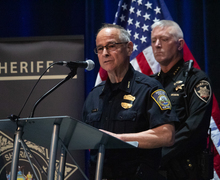Symphony orchestra to return to Syracuse
After more than a year of silence, the former members of the Syracuse Symphony Orchestra have developed a new strategy to revive the organization’s presence in the Syracuse community.
The Syracuse Symphony Orchestra folded in spring 2011 after it filed for bankruptcy and was forced to cease operations. Despite this, chairman of the Symphony Syracuse Foundation’s Board of Trustees Jon Garland has made plans to form an extension of the orchestra, The Post-Standard reported on Nov. 28. The orchestra plans to resurface as soon as the winter season, with talk of a holiday concert series.
The orchestra is having a holiday concert on Dec. 14. At the event, Garland plans to reveal the orchestra’s new name, as well as the dates for a winter and spring 2013 concert series throughout the Syracuse and Upstate New York region, The Post-Standard reported.
Under the interim name Musical Associates of Central New York, the organization will feature an entirely new business plan in which the success of each show determines how much or how little musicians are paid, said Vicki Feldman, a member of the Musical Associates of Central New York’s fundraising group.
Feldman was the former president of the Syracuse Symphony Association’s fundraising group, and was heavily involved with organizing fundraisers for the Syracuse Symphony Orchestra, she said. Feldman partnered with other women in the community 50 years ago to organize a full-time orchestra in Syracuse.
“The orchestra’s demise was very sad,” Feldman said. “It was everybody’s fault and nobody’s fault.”
Of the 79 musicians that left the Syracuse Symphony Orchestra, 65 had roots in the local community, Feldman said. The orchestra was a place where kids could be exposed to great music, and Feldman said she often took her grandchildren to various concerts put on by the Syracuse Symphony Orchestra.
James Tapia, director of orchestral activities at Syracuse University and former staff conductor of Syracuse’s Youth Symphony Orchestra, said the financial losses the Syracuse Symphony Orchestra experienced may have been exacerbated by the financial downturn associated with cultural institutions at that time.
“The recession created immediate consequences for arts everywhere,” Tapia said. “Still, it is absolutely vital that the symphony restock for the sake of the Syracuse community.”
Much of the symphony’s fan base was left empty-handed very abruptly, Feldman said. After the widely anticipated Yo-Yo Ma concert was canceled due to the symphony’s bankruptcy, many fans were not refunded their money and, as a result, felt deceived by the organization, she said.
Yet Feldman said she believes the Syracuse Symphony Orchestra’s fans will support the new project and see the emergence of a new management team focused on the needs of its consumers.
“This new project may be even better than before because it’s not as management heavy,” Feldman said. “It could turn out to be a model for other struggling orchestras that have the same issues that we had.”
A local orchestra is a necessary pillar of a community’s art culture, said Tapia, SU’s director of orchestral activities. The orchestra is moving in the right direction by making that pillar available again, he said.
“Syracuse is a community best served by a variety of cultural outposts,” Tapia said. “I can’t wait to see this organization come back full blown.”
Published on December 5, 2012 at 3:01 am
Contact Annie: [email protected]




